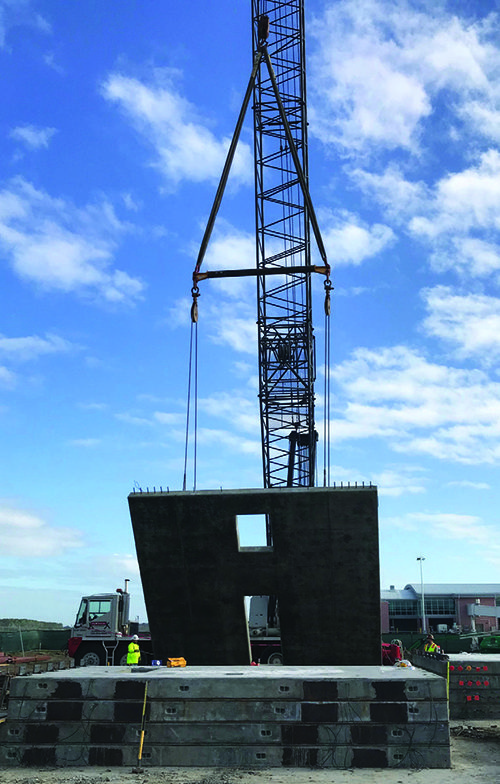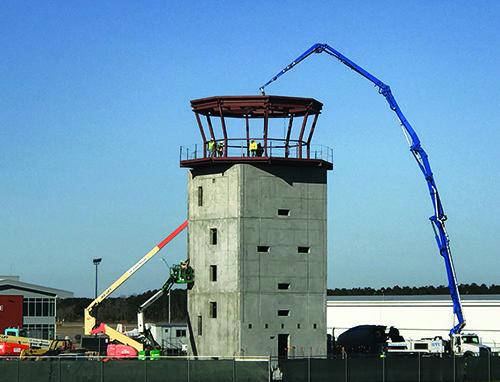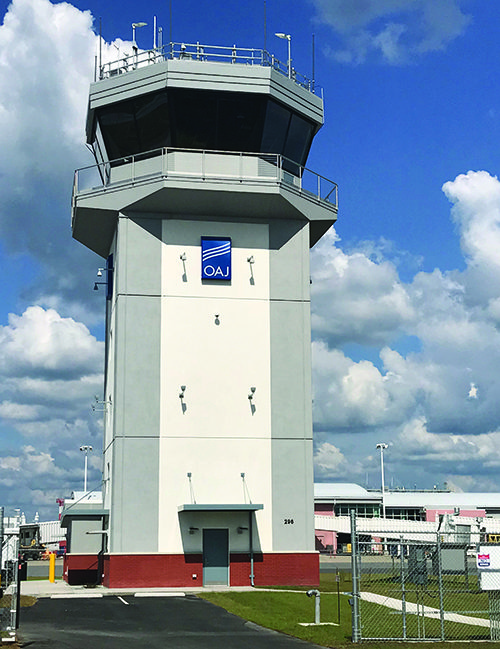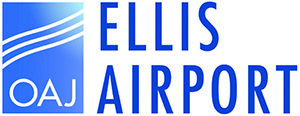It took a decade, but Albert J. Ellis Airport (OAJ) finally has its own air traffic control tower—a six-story, $6 million structure that officials hope will increase airspace efficiency and bring more air service to the small airport on the eastern coast of North Carolina.
It took a decade, but Albert J. Ellis Airport (OAJ) finally has its own air traffic control tower—a six-story, $6 million structure that officials hope will increase airspace efficiency and bring more air service to the small airport on the eastern coast of North Carolina.

Commissioned in November 2018, the new facility is the 256th tower operating under the U.S. Contract Tower Program. As such, OAJ paid to construct the tower (with help from state funds and federal grants) and foots its ongoing maintenance costs; FAA pays the salaries of the contract controllers who work there.
“This new tower enhances safety and improves efficiencies during busy periods,” says OAJ Airport Director Chris White, A.A.E. “More planes can now come and go during heavy traffic hours, and it opens the airport to accept larger and more air carrier operations, more cargo and more general operations. Some aircraft operators restrict the size of aircraft that can operate in an airport that is non-towered. This removes that restriction for Albert J. Ellis.”
|
Project: Air Traffic Control Tower Location: Albert J. Ellis Airport—Richlands, NC Cost: $6 million Size: 6 stories/91 ft. tall Funding: $2 million from FAA Airport Improvement Program; $2.4 million from state of North Carolina; $1.4 million from passenger facility charges Split Costs: Airport covers design/construction costs & ongoing building operation expenses; FAA pays cost of contract controllers Construction: Dec. 2017-Sept. 2018 Commissioned: Nov. 1, 2018 Project Consultant: RS&H Building Contractor: Daniels & Daniels Construction Lead Technical Design: RS&H Communications Consultant Responsible for Specifying Minimum Equipment List: CTBX Aviation Group Tower Operator: Robinson Aviation Inc. (RVA) Est. Building Operation Costs: $25,000/yr. |
The $6 million construction cost was partially paid for with $2 million in FAA Airport Improvement Program entitlements and $2.4 million from the North Carolina Department of Transportation-Division of Aviation. The remaining funds came from passenger facility charges. White estimates it will cost the airport about $25,000 per year to operate the building (insurance, electric utilities, refuse/janitorial services, etc.).
Because of the costs, OAJ was not on track to have an FAA-staffed tower. According to Spencer Dickerson of the American Association of Airport Executives/U.S. Contract Tower Association, an FAA-staffed tower can cost three times more than a tower staffed by an outside contractor. “Without this program, OAJ wouldn’t have a tower,” he states.
Dickerson says that over the past 15 to 20 years, the program has added air traffic control service at 150 previously non-towered airports. “It’s good for safety, it’s good for taxpayers and it provides more air traffic efficiencies throughout the system,” he explains.
Accommodating Mixed Traffic
White explains that it was essential for OAJ to have a tower because of its proximity to Camp Lejeune, a Marine Corps base with 50,000 active duty troops, and Marine Corps Air Station New River. The airport averages 106 daily operations—mostly from passenger aircraft and slow-moving rotor aircraft.
“But we also have Marine Corps charters and several squadrons of V-22 Osprey that come to OAJ to train,” he says. “You mix higher-speed commercial aircraft with slower-speed military aircraft, and then add in corporate and general aviation aircraft, and you have an interesting mix that benefits from a tower as far as separation and efficiencies for aircraft coming and going.”
Airport officials began the tower project in 2008 by submitting a formal application for a contract tower to the FAA. “You have to go through a complex benefit-cost analysis to be accepted into the program,” White says. “You have to prove it has more benefit than cost.”
The airport’s application was accepted one year later, but the project stalled due to a program slowdown, weak economy and lack of funding. The airport proceeded with a redevelopment program that included a new passenger terminal building, an executive terminal and other facilities while continuing to strategize about adding a tower.
By 2014, the program gained forward momentum, and OAJ solidified funding commitments and began siting and environmental work with consultant RS&H. Airport officials worked diligently with the state legislature and Department of Transportation for a $2.4 million grant, recalls White.
 Tarryn Little, project manager for RS&H, says the firm was involved from the beginning—assisting with the FAA application, helping secure funds, performing the site study and modifying the Airport Layout Plan.
Tarryn Little, project manager for RS&H, says the firm was involved from the beginning—assisting with the FAA application, helping secure funds, performing the site study and modifying the Airport Layout Plan.
“Back in 2009, we decided where we wanted the tower to go and placed utilities and roadways to preserve the site so that nothing would be constructed under or near it,” says White. “And we were fortunate that our ideal site was the site selected, as it was the highest natural point on the airport property. When you have a flat airport, that’s important. Even 10 feet will make a difference.”
The site’s elevation helped decrease construction costs, because taller towers require more elaborate and expensive foundations. The highest point of OAJ’s structure, including the antennae, is 91 feet. The controllers’ eye height is 60 feet.
Reduced Design Costs
RS&H based the design for OAJ’s tower on other contract towers it had designed. “We’re familiar with these types of buildings and used a similar design at Ellis in order to save on design costs, with modifications based on location, preferences, needs and, of course, the height,” Little explains.
The airport chose a “stout” cast-on-site reinforced concrete building to help the new facility withstand hurricane-force winds that can strike the North Carolina coast. “The wall panels were picked up with a crane and built on-site like an erector set,” recalls White.

The first floor contains fire and jockey pumps; the manager’s office occupies the second floor; the third floor houses a training room; the air traffic control equipment room is located on the fourth floor; the fifth floor is a break room; and the sixth floor the cab or control room. The tower can accommodate two to three controllers at a time and currently operates 15 hours per day, from 7 am to 10 pm. Operational hours can be expanded based on traffic projections.
Construction was delayed because bids came in higher than expected. RS&H consequently worked with the low bidder to value engineer its plans on several items, and construction eventually began in December 2017.
As specified by the design, the contractor had to complete most of its work before the FAA could install equipment. “There were some pretty hard dates we were required to follow in order to finish the project on time,” comments Little.

Just as construction neared completion, Hurricane Florence struck, damaging the building’s elevator. “The FAA could not perform its work without an elevator, so the contractor actually paid to have people carry all the FAA’s equipment up the five flights of stairs,” she recalls.
Operational Issues
Robinson Aviation Inc. (RVA), which has partnered with the FAA for more than 30 years, operates the tower at OAJ and employs its air traffic controllers. Under a territory agreement awarded by the FAA, the private company operates 100 contract towers throughout the south and southeastern United States.
Jim Slate, vice president of Air Traffic Services, reports that staffing is the company’s main challenge. “We’re not able to teach people how to be air traffic controllers; we have to find people who already are controllers,” he explains, noting that most Robinson Aviation employees are retired FAA controllers or retired military controllers. “At certain times, it is tough to find candidates.”
 As a result, contract towers tend to have high turnover. “Since we hire a lot of people who are retired, they only work for a finite number of years before they fully retire,” he remarks. “That requires us to have a constant hiring process.”
As a result, contract towers tend to have high turnover. “Since we hire a lot of people who are retired, they only work for a finite number of years before they fully retire,” he remarks. “That requires us to have a constant hiring process.”
Time is usually of the essence. “Once a tower is equipped and ready, the FAA will give us a short amount of time to relocate controllers, ensure they are familiar with the airspace and officially open the tower,” says Slate. “No airport board wants a new tower to sit there for a long period of time without being open.”
Hurricane Florence added a special complication to the OAJ tower opening by rendering many local housing options inhabitable due to flooding and other damage. “The hurricane hit when the controllers were getting ready to move in,” Slate recalls. “It was a challenge to find affordable housing.”
Filling a Need
Currently, 256 airports in 46 states have contract towers. Two (OAJ and North Texas Regional Airport – GYI) opened new facilities in the second half of 2018, and Dickerson predicts that two to three more will add contract towers annually over the next few years.
Most federal contract air traffic controllers are former FAA or military controllers, and 70% are veterans. All are FAA-certified and undergo the same training and are required to follow the same operation standards as FAA-employed controllers.

 According to Dickerson, the 36-year Contract Tower Program has strong bipartisan support in both houses of Congress. “The bottom line is that without this program, many airports would not have towers. If you have a certain level of operations or weather issues or typography or unique airfield configurations, it makes sense to have active controllers at an airport.”
According to Dickerson, the 36-year Contract Tower Program has strong bipartisan support in both houses of Congress. “The bottom line is that without this program, many airports would not have towers. If you have a certain level of operations or weather issues or typography or unique airfield configurations, it makes sense to have active controllers at an airport.”
At OAJ, the new contract tower is aligning the airport with current traffic and supporting future development. “We were one of the busiest airports in the country in terms of people served without a tower,” says White. “We really pushed for it and it’s been the theme of our entire redevelopment program. It’s not a build-it-so-they-will come type of program. It’s a build-it-so-they-can come program. We’ve removed facility constrictions and operational constraints so the airport can continue to grow.”


 facts&figures
facts&figures

